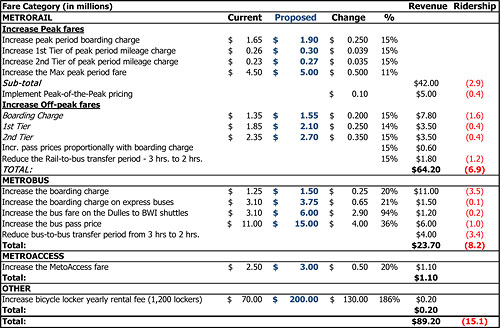WMATA budget deep dive, part 3: Fare proposals
WMATA’s proposed FY 11 budget calls for a $87.9 million Metrorail and Metrobus fare increase as part of its proposal to close a $190 million budget gap. Some fare increases carry larger ridership losses than others, which gives us a way to evaluate these fare proposals and suggest alternatives.
Overall fare increases on Metrorail average a little over 15% whereas bus fares rise over 20%. The fare increases are expected to cost WMATA 6.9 million lost passenger trips on rail and 8.2 million lost passenger trips on bus for a total of 15.1 million lost.
The fare increases proposed are some of the largest ever on the WMATA system. Fare increases and service reductions proposed would likely be even higher if an additional $40 million from an unidentified source were not included in the FY11 budget.
During the FY 10 budget gap hearings earlier this year, riders overwelmingly supported a fare increase over service reductions but the fare increase was much lower than the one proposed now. Two years ago the WMATA board adopted a policy of semi-annual fare increases tied to the rate of inflation rounded up to the nearest nickel. Unfortunately, applying this formula would only raise around $35 million, or a little more than a third of the fare increase now proposed.
If fares increases drive down ridership too much, as with service reductions, they could trigger a downward spiral of reduced revenues that creates more budget gaps in the future resulting in more fare increases and service reductions.
This seems to be a danger particularly with the proposed Metrobus fare increases. The biggest components in ridership loss are the the bus base fare increase at 3.5 million riders lost and the reduction of the bus to bus transfer period reduction from 3 hours to 2 hours which projects to lose 3.4 million riders. Combined, these make up over half the total ridership loss.
One aspect of the Metrorail fare increase that needs to be re-evaluated in terms of its impact on passengers is the increase in off-peak fares. WMATA has experienced an increase in short-trips—primarily in off-peak hours. It may be wise to encourage these short trips by not increasing the fare as much. A reduction in the proposed off-peak Metrorail fare from $0.20 to $0.15 would cost about $2 million and would save about 400,000 passenger trips.
Next: Some ways to soften the blow of fare increases.

